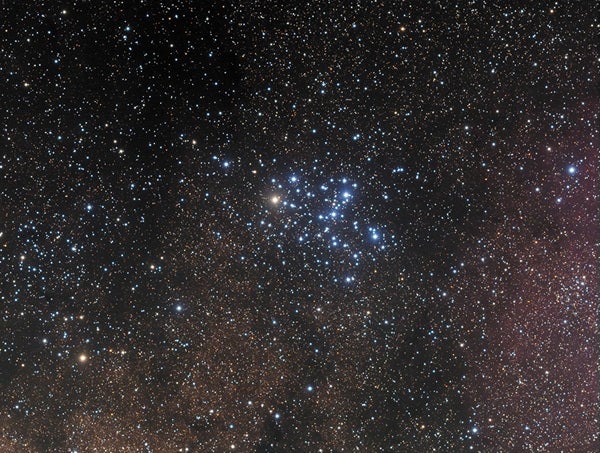Saturday, August 14
Look to the southern sky this evening to explore the central regions of our Milky Way, whose core falls near the Teapot’s spout in Sagittarius. The waxing Moon is nearby in Libra, potentially washing out the Milky Way’s disk even from slightly darker locations, but there’s still plenty to be seen here, as this is a region rich with star clusters.
Several sit in the domain of Scorpius, who lies west of Sagittarius in the sky. Two are M6 and M7, which sit just above the stinger at the end of the Scorpion’s tail. First find magnitude 1.6 Shaula (Lambda [λ] Scorpii); just to this star’s lower right (southwest) is magnitude 2.7 Lesath (Upsilon [υ] Scorpii). Together, these two stars make up the tail’s stinger. They are sometimes called the Cat’s Eyes.
Draw a line from Lesath to Shaula, then continue that line about 4.5° in the same direction. You’ll run smack dab into M7, an open cluster also known as Ptolemy’s Cluster. With a visual magnitude of about 3, it should be visible to the naked eye under dark skies. If not, binoculars or any size telescope will bring it out. This cluster sports roughly 80 stars brighter than magnitude 10 within about 1.3° of the sky. These stars are all young suns recently born within the last 220 million years or so.
Next, it’s a short journey to M6, which lies a little less than 4° north-northwest of M7. Like its neighbor, M6 is a young open cluster that’s just a little fainter at magnitude 4. It is sometimes called the Butterfly Cluster, as its stars resemble a butterfly with its wings outspread. This cluster is even younger — around 100 million years — and its brightest star, HD 160371 (also called BM Scorpii), is a variable whose magnitude ranges from 5.5 at its brightest to 7 at its dimmest. This star is easy to pick out from its blue-hued brethren, as it is distinctly orange in color.
Sunrise: 6:11 A.M.
Sunset: 7:58 P.M.
Moonrise: 12:46 P.M.
Moonset: 11:31 PM
Moon Phase: Waxing crescent (40%)
Sunday, August 15
First Quarter Moon occurs at 11:20 A.M. EDT. This is an easy lunar phase to observe, as the Moon rises in the afternoon and doesn’t set until shortly after midnight. During this phase, the eastern portion of our satellite is illuminated, which (in the Northern Hemisphere) means that its right half is visible. This puts on display six of its large, dark maria: the Seas of Cold, Serenity, Tranquillity, Nectar, Crises, and Fertility. It was in the Sea of Tranquillity, the roughly oval-shaped dark patch beneath the more circular Sea of Serenity, that the first men landed on the Moon in July 1969. In addition to these lava-filled basins, several craters also stand out on the First Quarter Moon. The most prominent include Langrenus, Theophilus, Hercules, Aristoteles, and Atlas.
Now is also a great time to study the Moon’s terminator, or the line between lunar night and day. This is where contrast is often sharpest and where details truly stand out. If you observe the Moon for long stretches of time, you may even see the shadows change as daylight creeps across our satellite. Whether you have binoculars, a telescope, or no equipment at all, the Moon is an excellent target for all observers to enjoy.
Sunrise: 6:12 A.M.
Sunset: 7:56 P.M.
Moonrise: 1:59 P.M.
Moonset: —
Moon Phase: Waxing gibbous (51%)
Monday, August 16
Early this morning, Jupiter’s moons will put on a special show. Mutual events in which one moon or its shadow block another are only possible when we’re viewing the giant planet at just the right angle — as we are now. Observers in the central and western portions of the U.S. should look this morning with a telescope near the border of Aquarius and Capricornus to find bright Jupiter (magnitude –2.9) still in Aquarius, about 1.5° west of magnitude 4.2 Iota (ι) Aquarii.
The planet sits in a rich starfield, with Io 1.5° to Jupiter’s east and Callisto, Ganymede, and Europa (from east to west) about 3.5′ to the west. Ganymede’s large shadow falls across Europa between 5:03 A.M. and 5:35 A.M. CDT, followed by a 10-minute-long occultation as Ganymede itself blocks Europa from 5:43 A.M. to 5:53 A.M. CDT. By then, it’s twilight in the Midwest, so observers in Mountain and Pacific time zones will get the best view in the darkest sky. Note that Callisto is only 13″ east of the pair.
Sunrise: 6:13 A.M.
Sunset: 7:55 P.M.
Moonrise: 3:13 P.M.
Moonset: 12:06 A.M.
Moon Phase: Waxing gibbous (62%)
Tuesday, August 17
Omicron (ο) Ceti, better known as Mira, is a long-period variable star whose brightness waxes and wanes over a period of 332 days. This star is estimated to peak in brightness tomorrow, meaning this is a great time to enjoy its magnitude 2 to 3 glow (Mira’s peak magnitude varies somewhat) without any optical aid at all.
The best time to search out Mira and its home constellation of Cetus is early in the morning in the few hours before sunrise, when this region sits highest in the sky at this time of year. Mira is located in the central region of the constellation, a little less than halfway down a line drawn between Menkar (Alpha [α] Ceti) and Diphda (Beta [β] Ceti). At its peak, Mira should appear roughly as bright as the latter.
Over the next half a year or so, Mira will fade down to magnitude 9, disappearing from naked-eye view altogether. It will again peak in brightness in mid-July next year.
The Moon reaches perigee, the nearest point to Earth in its orbit around our planet, at 5:16 A.M. EDT. When it does, our satellite will sit 229,363 miles (369,124 kilometers) away.
Sunrise: 6:14 A.M.
Sunset: 7:54 P.M.
Moonrise: 4:24 P.M.
Moonset: 12:48 A.M.
Moon Phase: Waxing gibbous (73%)










